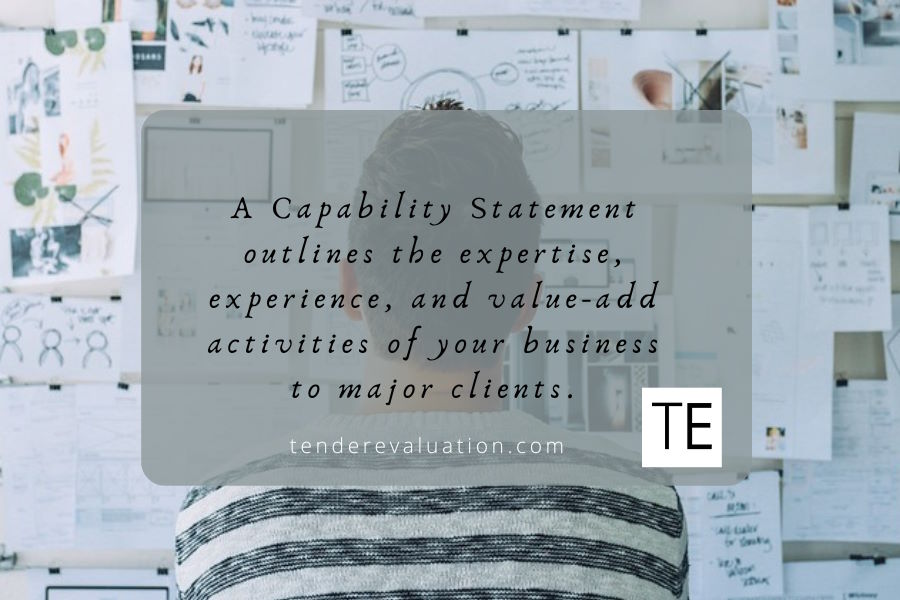Looking to break into government contracting via tendering? If so, you may have come across mentions of a requirement for a “capability statement.” But what exactly is one, and why is it important for winning government tenders?
In this article, we’ll look into the importance of capability statements in the tendering process and show you some valuable insights on customising them to suit specific opportunities. And if you’re stuck on what to include in a basic capability statement, so prospective clients, employees and decision-makers know all they need to about your company, keep reading!
What is a Capability Statement?
A capability statement is a short but comprehensive summary showcasing your business’s core competencies, past performance, experience and expertise, and professional image, along with any other relevant information potential clients may require during their evaluation process.
It communicates your company’s unique offerings and strengths to your target audience and serves as an effective tool to help you stand out and gain an advantage over your competitors when bidding on contracts or pursuing new opportunities with major clients.

Importance In Winning Tenders
In today’s competitive marketplace, having an impactful capability statement can be the key to securing lucrative contracts and growing your business through successful tendering efforts. Here are some reasons why investing time into writing and crafting an excellent capability statement is essential:
- Demonstrates expertise – A well-written capability statement highlights your company’s skills and experience by showcasing relevant projects completed successfully in the past.
- Sets you apart from competing businesses – By emphasising what makes your business unique – such as specialised services or innovative solutions – you increase your chances of being selected over other bidders who might not have those specific attributes.
- Fulfils procurement specifications – Many government agencies mandate submitting a detailed capability statement along with bid proposals; thus, having one ready ensures compliance with these regulations.
- Facilitates networking – When attending events or meeting with potential customers, having a polished capability statement can help you make a lasting impression and open doors to new opportunities.
Key Takeaway
To secure more lucrative contracts and grow your business through successful tendering efforts, your business will need a capability statement that makes an impact, tailoring each opportunity to its audience to communicate your company’s strengths, and addressing the needs of those involved in the tender evaluations.
Creating An Effective Capability Statement
Crafting an impactful statement requires tailoring it according to each opportunity, so ensuring you directly address the needs of your prospective client, its target audience and the decision-makers.
Treating it as a dynamic document, create a capability statement template, and customise it as needed, based on your thorough research of your potential client’s requirements so that it accurately reflects their expectations.
Researching your client’s needs
To create a targeted and relevant capability statement, you must first understand your potential or prospective client side’s needs and preferences.
Begin by researching the agency or contractor’s mission, goals, and priorities. This information can often be found on their official websites or through public announcements related to procurement opportunities.
Additionally, consider attending industry events where representatives from these organisations may be present to gain further insights into their unique business challenges and objectives.
Finding relevant information online
There are several sources you can use to find relevant information to help write a capability statement suitable for Australian government departments:
- The Australian Government’s AusTender website – the central source of information on Australian Government procurement, where you can search for open tenders, contract notices, and awarded contracts. This information can be a treasure trove, and provide a lot of ideas about the types of services and products the federal government looks for, along with common prerequisites often seen in proposal submissions.
- Industry associations – They provide valuable insights into the needs of specific government agencies and the types of services and products that are in demand. They may also provide networking opportunities and other resources for businesses interested in government procurement.
- Government agency websites – Many government agencies have websites with information on their procurement processes, including the types of services and products they require and the criteria they use to evaluate proposals.
- Read this Financial and technical capability guideline example from the QLD Department of Natural Resource, Mines and Energy.
- The Business.gov.au portal has a wide range of resources and tools for businesses interested in government procurement. Also includes information on how to find and respond to government tenders.
AusTender: How To Find Your Next Government Tender
Tailoring content for specific opportunities
Taking the time to create custom capability statements will not only increase your chances of winning bids but also help establish credibility with potential clients, especially in a larger organisation, as they recognise your commitment to understanding their unique business needs and objectives.
Follow these guidelines to tailor your document for each opportunity:
- Address specific needs – Highlight how your core competencies and past performance are directly related to the client’s stipulations, emphasising relevant experience in similar projects or industries.
- Showcase unique differentiators – Identify what sets you apart from competing businesses and explain why these attributes make you an ideal partner for the agency or contractor. This could include innovative solutions, specialised expertise, or a proven track record of success in challenging environments.
- Maintain clarity and conciseness – Keep your capability statement focused on essential information that demonstrates value while avoiding unnecessary jargon or overly technical language. Aim for a concise yet comprehensive presentation of your company’s strengths and offerings. Use bullet points.
Key Takeaway
Crafting an impactful capability statement requires tailoring it according to each opportunity by addressing the needs of prospective clients, specific government agencies or prime contractors involved in tender evaluations.
Essential Components of a Capability Statement
A good capability statement should include information such as a complete company overview, competencies, experience and expertise, your differentiation and your organisation’s structure.
These elements provide evidence that your business has successfully completed similar work while also highlighting any unique attributes setting you apart from competitors.
Company overview details
Your capability statement template should begin with an engaging company overview that concisely describes your business’s mission, vision, and history. This section helps potential clients understand who you are and what drives your organisation to excel in its industry.
Make sure to mention any relevant certifications or awards that showcase the credibility of your business, as well as contact details.
Core competencies examples
The next section outlines the key core competencies of your business-specific skills or expertise that set you apart from other companies bidding on the same project. Be specific about how these competencies have been developed over time through experience, training programs and qualifications.
It is essential to align these business capabilities with the guidance mentioned in tender documents so potential clients can easily see why they should choose you for their projects.
- Data analysis – Expertise in analysing large datasets using advanced statistical techniques for informed decision-making processes.
- Digital marketing – Proven track record in creating effective online campaigns across various platforms (e.g., social media channels) leading to increased brand awareness and sales growth.
- Cybersecurity management – Comprehensive knowledge of best practices for securing digital assets against cyber threats based on years of experience working with clients in various industries.
Past performance documentation
One of the most critical aspects of a capability statement is providing evidence of your past performance. This section should include examples of successful projects completed by your company, highlighting how they align with the tender’s requirements.
Include any testimonials or case studies that demonstrate client satisfaction and positive outcomes resulting from your work. You may also want to link to an online portfolio showcasing these achievements for easy reference.
Differentiators showcasing uniqueness
In this section, highlight what sets you apart from other businesses competing for the same tenders, products and services i.e. your unique selling points (USPs).
These differentiators could be anything from innovative technologies used in service delivery to exceptional customer support provided throughout project execution. Make sure these differentiating factors are relevant and valuable to potential clients so they can see why choosing your business would be advantageous over others.
Key Takeaway
It is essential to write your capability statement to align your capabilities with the requirements mentioned in tender documents so potential clients and customers can easily see why they should choose you for their projects.
Highlight what sets you apart from other businesses competing for the same tenders – your unique selling points (USPs).
How to Avoid Common Mistakes In Capability Statements
When you intend to write and deliver a capability statement, it is crucial to avoid certain pitfalls that might detract your written document from its overall impact.
Eliminate irrelevant content
Including outdated or unrelated information in your capability statement can make it difficult for evaluators to understand your company’s core competencies and unique offerings. To maintain focus on what truly matters, consider the following tips:
- Remove any details about past projects or clients that are not relevant to the specific opportunity at hand.
- Avoid using industry jargon or buzzwords without providing clear explanations of their relevance.
- Keep the document concise by focusing on key points rather than lengthy descriptions.
Ensure accuracy and verifiability
Making false claims or presenting inaccurate data within your capability statement can lead to disqualification during tender evaluations. To ensure all information presented is accurate and verifiable:
- Cross-check all facts, figures, and statistics with reliable sources before including them in your document.
- If possible, provide links to third-party websites where evaluators can verify the authenticity of awards, certifications, or other achievements mentioned (e.g., “ISO certification page“).
- Avoid exaggerating accomplishments; instead, showcase genuine success stories backed up by evidence such as client testimonials.
An Example of Why a Great Capability Statement Matters
A client in the helicopter services sector used a refocused capability statement created for them by Tender Evaluation to engage with the decision-makers of their client. This led to an executive meeting, discussing a new approach to solving particular challenges of providing marine pilot transfers in a busy port environment.
The outcome? An invitation to submit a detailed, costed proposal. And after negotiations, our client secured a five-year contract.
Using Your Capability Statement Effectively
Once you have prepared your business capability statements for various opportunities, the next step is to decide how to use them effectively in order to maximise your chances of winning bids on lucrative projects.
Responding to an EOI or RFP
An Expression of Interest (EOI) or Request for Proposal (RFP) is usually issued by government agencies or primary contractors seeking potential suppliers for specific projects.
When responding to these notices, ensure that you submit a customised capability statement that addresses the conditions outlined in the notice. Follow any specific directions provided by the issuer and include all requested information within the given deadline.
- Tailor your response – Customise your capability statement according to each opportunity based on thorough research about potential your clients’ requirements.
- Prompt submission – Submitting your response within the specified timeframe demonstrates professionalism and commitment.
- Detailed documentation – Provide clear evidence of past performance, core competencies, differentiators, and company overview details relevant to the project at hand.
Understanding EOI, RFP, and RFT in Tendering: A Business Owners Guide
Meeting with Government sector representatives and prime contractors
In addition to responding directly through written proposals or online submissions, engaging face-to-face with government sector representatives or prime contractors can be an effective way of showcasing your capabilities as a supplier.
Use networking events such as industry conferences or trade shows as opportunities for presenting an updated, visually appealing version of your tailored capability statement while discussing potential collaborations with new suppliers and customers. Here are some more tips for successful interactions:
- Be prepared – Have printed copies of your capability statement on hand, and be ready to discuss its content in detail.
- Demonstrate expertise – Show that you understand the agency’s or prime contractor’s needs by discussing how your core competencies align with their requirements.
- Create a lasting impression – Leave behind a memorable impression by being professional, confident, and engaging during these meetings. This will increase the likelihood of future opportunities arising from such interactions.
Key Takeaway
To win bids on lucrative projects, it’s important to use your tailored capability statements effectively.
When responding to EOI or RFP, submit a customised capability statement that addresses the prerequisites outlined in the notice and provides clear evidence of past performance.
Engaging face-to-face with agency representatives or prime contractors can also be effective by demonstrating expertise and leaving behind a memorable impression.

Frequently Asked Questions about Capability Statements
What should a capabilities statement include?
A capability statement draft should include a complete company overview, core competencies, past performance documentation, items of differentiation showcasing the uniqueness of your business, and its contact details. Ensure you modify the content to the specific opportunity by researching your potential client.
What is the importance of a capability statement?
Capability statements are important for businesses seeking government contracts or partnering with prime contractors. They showcase your business’s expertise, experience, and unique offerings to potential clients while demonstrating your ability to meet their needs effectively.
How do you write a powerful capability statement?
To write a powerful capability statement:
- research your client’s needs;
- customising the content for the specific opportunity;
- provide an engaging company overview;
- list relevant core competencies;
- document past performance with examples;
- highlight differentiators that set you apart from the competition.
What is a capability statement best practice?
Best practices for writing and creating effective capability statements involve eliminating irrelevant content, ensuring the accuracy and verifiability of the information provided, and using clear language and visuals to communicate key points concisely.
Why Capability Statements Can Help You Win More Tenders
As you saw in our example about the helicopter services client above, crafting an effective capability statement is crucial for success. Whether you’re new to government contracting or looking to refine your approach, a good capability statement can be the key differentiator that sets your company apart from competitors and wins those tenders for your business.
By following our tips on what should be included in your company’s capability statement (and what not to include!) your team will be able to create an effective document that accurately reflects your company’s story – helping it stand out from the competition and help you secure new business opportunities.
Need to know more? Talk to a tender proposal expert!
Whether you need a capability statement, a winning bid proposal or a tender presentation that will make your organisation stand out from the competition, our tender evaluation consulting team provides the professional guidance you need to win more tenders.


